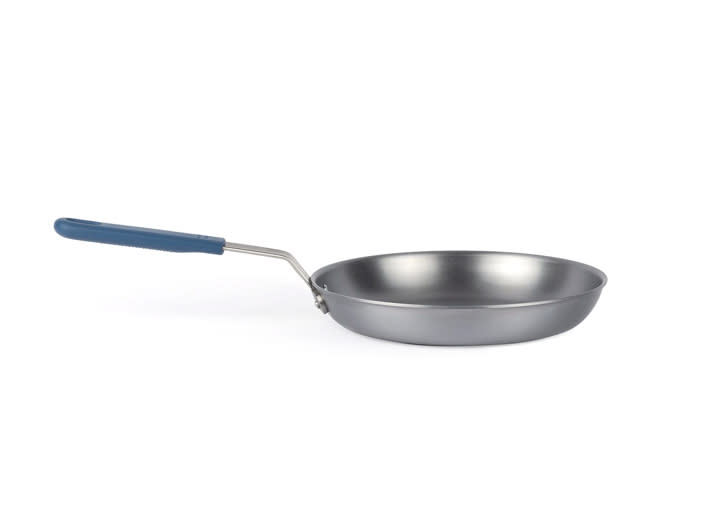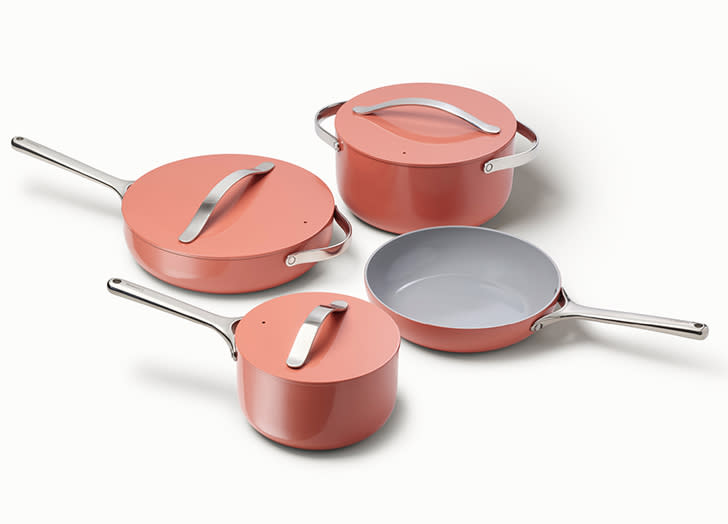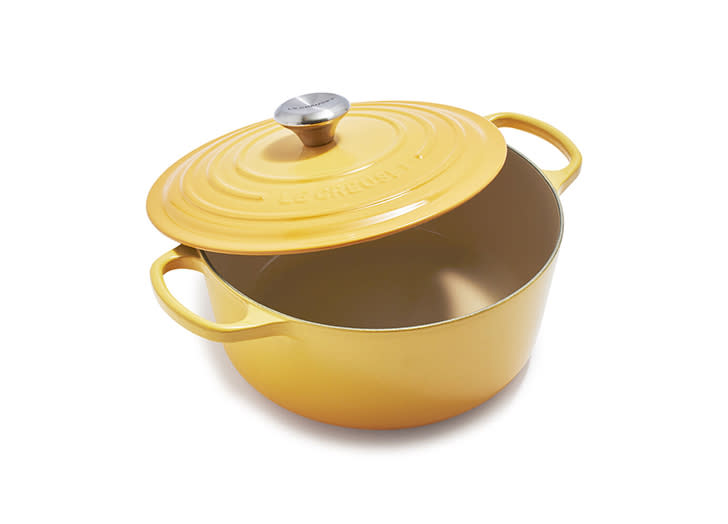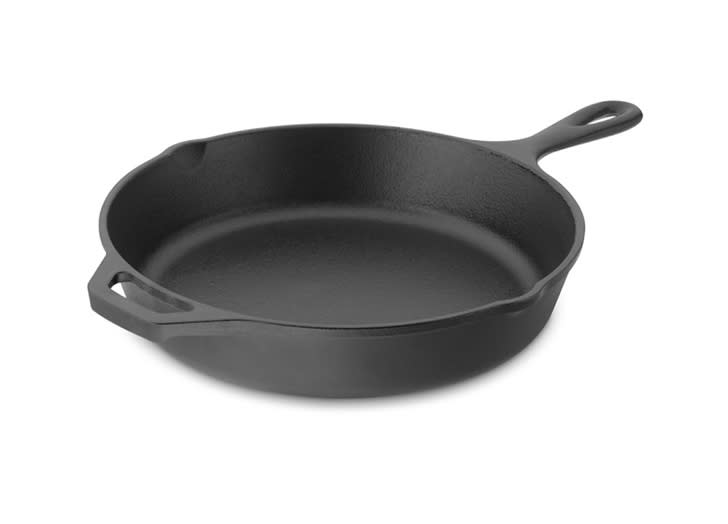The 10 Best Non-Toxic Cookware Options You Can Buy, According to a Food Editor

If you’re still sautéing kale with the same nonstick skillet you bought when you moved into your first apartment, we have some news for you: It’s time to invest in new cookware. Did you know that your old, scratched-up pots and pans could be leeching toxic chemicals into your otherwise impeccable dinners? Yikes is right. Here, we’ll explain why you’re (inadvertently) serving up harmful chemicals and how to replace your current cookware with a few safer options (from eco-friendly enameled nonstick to tried-and-true cast iron).
RELATED: The 5 Best Stand Mixers for Every Need
The best non-toxic cookware, at a glance:
Best Carbon Steel: Misen Carbon Steel
Best for All Skill Levels: GreenPan
Best Ceramic Set: Caraway
Best Multitasker: Our Place Always Pan
Best Chef-Approved Brand: Scanpan
Best Enameled Cast Iron: Le Creuset
Best Stainless Steel: All-Clad Stainless Steel
Best Cast Iron: Lodge Cast Iron
Best Nonstick Set: Made In The Non Stick Set
Best Copper-Core Nonstick: Material Kitchen The Coated Pan
Scroll down for in-depth reviews of each.
But first, what is non-toxic cookware?
Sure, you might buy organic, pesticide-free produce, but did you know that what you cook it in is just as important? For a long time, Teflon (also known as PTFE or polytetrafluoroethylene, if you’re fancy) was the gold standard for ultra-slick, nonstick pots and pans. But over the past 25 years, the FDA has discovered that certain chemicals (specifically PFOA, or perfluorooctanoic acid) used in manufacturing Teflon are actually toxic to the environment and our health, and can build up in your body over time.
You’ve also probably heard that it’s bad to use metal utensils on nonstick cookware. That’s because when you scratch the surface, you give those harmful compounds a chance to get a little too friendly with the food you’re about to eat. Thankfully, those substances have been slowly phased out of production, but it’s still important to read the label on any nonstick cookware before purchasing.
What’s the best way to avoid potentially hazardous cookware?
That’s easy: Just steer clear of items labeled “nonstick” without any further indication of what they’re actually made of. The bargain pan without a tag that you found in the sale section of your favorite home goods store? You might want to skip that deal in favor of something that’s clearly labeled, even if it happens to be a little more expensive.
What is the safest cookware for your health?
Plenty of cooking materials are just as nonstick as Teflon without being potentially harmful to your health. (They’re probably of higher quality, too.) That includes…
Ceramic, which is nonstick, scratch-resistant and very easy to clean
Cast iron, which will last for years when treated well, is extremely versatile and retains heat like nobody’s business
Carbon steel, which is similar to cast iron but is smoother and more lightweight
Stainless steel, which is not nonstick but is durable, widely available and often relatively inexpensive
What cookware materials should you flat-out avoid?
When choosing cookware that’s both high quality and good for you, always check the manufacturing notes and avoid…
Teflon, also known as PTFE or polytetrafluoroethylene
PFOA, or perfluorooctanoic acid, which is sometimes just labeled with the catch-all term “nonstick”
Now that you’re educated on all things cookware, here are the best non-toxic cookware brands we’ve found and loved.
The 10 Best Non-Toxic Cookware Options on the Market

1. Misen Carbon Steel Pan
Best Carbon Steel
Like cast iron, carbon steel cookware is made from an alloy of iron and carbon—the difference is that it contains less carbon than cast iron. It’s just as non-toxic, but much more lightweight and a better heat conductor than its clunkier cousin. And thanks to that lower carbon content, it’s smoother and slightly more non-stick, even though it’s seasoned the same as cast iron. We like the Misen carbon steel skillet because it heats quickly and evenly, is super slick with regular seasoning, goes from the stove to the oven and works on gas, electric and induction burners. It’s also a cool $65 for a ten-inch pan, which is a steal considering it’s meant to last a lifetime.
Pros:
Heats evenly and quickly
Lightweight but durable
Cons:
Requires regular maintenance (i.e., seasoning)
Not dishwasher-safe

2. GreenPan
Best for All Skill Levels
GreenPan is kind of like the OG of non-toxic, nonstick cookware. The brand uses a silicon-based coating called Thermolon, which is slippery and scratch-resistant and doesn’t run the risk of releasing harmful chemicals into your food, even if you accidentally overheat the pan. (It can withstand temperatures up to 850°F, but for your safety, we don’t suggest trying that!) While there’s no shortage of styles to choose from—GreenPan even makes non-toxic grill pans—we’re partial to the GreenPan Venice Pro two-piece set, which includes a 10- and 12-inch skillet with a stainless steel outer finish. Bonus: They’re dishwasher-safe.
Pros:
Dishwasher-safe
Slick, heat-resistant surface is ideal for beginner cooks
Cons:
Can’t be used with metal cooking utensils

3. Caraway
Best Ceramic Set
For the home cook who wants her kitchen to look as good as the food she’s making in it, there’s Caraway. It comes in a slew of muted, cheerful colorways like perracotta (a creamy brownish rose) and sage (a calming green), but it’s not just Instagram-friendly: It’s made with a ceramic nonstick coating that can handle temperatures up to 550°F, it can go from stove top to oven and it won’t add unwanted chemicals to your meals. Every piece in the set is stove-top agnostic, a fancy way of saying it works with induction, gas and electric ranges, plus they ship in recyclable, environmentally conscious packaging. (Psst: We rated the set 90 out of 100 in our PureWow100 review.)
Pros:
Heats evenly and is oven-safe
Comes in many colors
Easy to clean
Cons:
Can’t be used with metal cooking utensils
Lid handles get hot

4. Our Place
Best Multitasker
If you’re short on storage space and don’t want to invest in a gigantic 12-piece set (yet), the Always Pan by Our Place can do the same heavy lifting as eight different cookware pieces. The 10-inch skillet—which is made from fully ceramic-coated aluminum—comes with a nesting steamer basket, a spatula with its own built-in spoon rest, and a lid that allows you to choose whether to keep steam in or let it out. All in all, it gets an A-plus from us for versatility and convenience, not to mention cuteness.
Pros:
Comes in many colors
Easy to clean and store
Cons:
Can’t be used with metal cooking utensils
Not dishwasher-safe

5. Scanpan
Best Chef-Approved Brand
Scanpan is highly recommended by plenty of chefs working in professional kitchens. “I love and use Scanpan all the time,” says Barbara Rich, culinary arts lead chef at the Institute of Culinary Education. The Danish cookware is nonstick, heats evenly, is lightweight enough to flip pancakes and omelettes, and is oven safe up to 500°F, if you’re more of a frittata person. The CS+ line has the look of brushed stainless steel, but its interior actually has a food-safe, micro-textured ceramic-titanium finish for a slick surface that’s ideal for searing and browning. We suggest picking and choosing from the brand’s robust lineup (start with the 11-inch skillet) if you don’t want to commit to an entire set.
Pros:
Surface is both nonstick and ideal for searing
Dishwasher-safe
Brand offers many sizes and styles
Cons:
Can’t be used with metal cooking utensils

6. Le Creuset
Best Enameled Cast Iron
Yep, the fancy French brand that you lust after on Pinterest also happens to be non-toxic. And while it’s certainly not cheap, the price can be justified when you consider how the cookware is famous for being so durable. Aside from the aesthetic appeal, Le Creuset’s ceramic-coated cast iron conducts and holds heat like a dream, goes from stove to oven to table, is scratch and chip resistant, and is incredibly easy to clean (say goodbye to the infamous overnight soak). The brand makes skillets and pots of all sizes, but we’re partial to the 5.5-quart Dutch oven for its versatility. The only hard part? Choosing a color.
Pros:
Comes in many colors
Durable
Cons:
Heavy and not dishwasher-safe
Cost-prohibitive

7. All-Clad Stainless Steel
Best Stainless Steel
There’s a reason everyone puts All-Clad on their wedding registry: It’s as timeless and good-looking as it is functional. The stainless steel cookware is not nonstick, but it also contains no toxic coatings either. It’s oven- and dishwasher-safe, won’t scratch if you accidental take a metal utensil to it, heats up quickly with no hotspots and comes with a lifetime warranty. We like the so-called Weeknight Pan, which is like a hybrid sauté pan and saucier, because its high sides and ample surface area can handle braising, sautéing, searing and simmering with ease. (And with a little cooking oil, it can handle anything a nonstick pan can.)
Pros:
Heats evenly and is oven- and dishwasher-safe
Safe for use with metal cooking utensils
Cons:
Surface is not inherently nonstick

8. Lodge Cast Iron
Best Cast Iron
For a do-it-all pan that’s easy on your budget and will last you and your grandkids a lifetime (if you take care of it), look no further than a cast-iron skillet. Why? Because after just a few uses it becomes seasoned (i.e., coated with layers of built-up cooking oil), which is food safe and surprisingly nonstick. Lodge’s pans have been a favorite among home cooks for years—probably because they’re inexpensive and durable and they hold heat like no other. (It doesn’t hurt that they look rustic-chic, too.) A 10-inch skillet is a good all-purpose size for daily cooking, but for feeding crowds and tackling bigger tasks like roasting whole chickens, we also like the larger 12-inch version. Not sure how to wield cast iron the right way? We’ve got a few tips.
Pros:
Versatile and durable
Holds heat evenly and consistently
Cons:
Not dishwasher-safe
Requires regular maintenance (i.e., seasoning)

9. Made In The Non Stick Set
Best Nonstick Set
Some people prefer pretty colors, while others want their cookware to look über-profesh. For the latter camp, there’s this nonstick set from Made In. It comes with everything you need to outfit your kitchen: an 8-quart stock pot with lid, a 4-quart sauté pan with lid, a 4-quart saucepan with lid and a 10-inch frying pan. The pieces feature a 5-ply stainless clad outer and a PFOA-free nonstick inner coating for easy cooking and cleanup.
Pros:
The look of stainless steel with a nonstick finish
Oven-safe
Cons:
Not dishwasher-safe
Can’t be used with metal cooking utensils

10. Material Kitchen The Coated Pan
Best Copper-Core Nonstick
Most copper cookware will try to bankrupt you and run; Material’s nonstick pan plays nice. It’s made with a copper core and stainless steel outer, so it has all the even-heat benefits of traditional copper cookware without the hefty price tag (plus it won’t warp or scorch). The nonstick surface is made of a nontoxic stainless steel alloy, the pan works on all types of stovetops and it’s available in two elegant colors.
Pros:
Copper core heats evenly while stainless outer prevents warping and scorching
Nonstick inner surface
Cons:
Not safe for use with metal cooking utensils
How to take care of non-toxic cookware:
Each type of cookware has different care instructions. (For instance, you’ll never catch us putting our cast-iron skillet in the dishwasher!) But there are also a few universal best practices when it comes to extending the life of any non-toxic pot or pan. That includes…
Avoiding metal utensils: Even if a brand says it’s scratch-resistant, we like to play it safe and opt for wooden spoons and silicone spatulas when frying and flipping. This ensures your cookware will last for years. The exception? Stainless steel is pretty impervious to abuse.
Washing by hand whenever possible: Again, many brands are dishwasher safe, which is a major plus. But we still prefer to hand-wash our pots and pans to really keep them in tip-top shape.
Cleaning with a gentle sponge: Please, we beg you, do not take your steel-wool scrubber to your coated pans (unless they’re stainless steel). We’re not saying it will scratch them, but why would you risk it? A drop of dish soap, a generous soak and a gentle scrubby sponge should do the job just fine (unless it’s cast-iron or carbon steel, which will both rust when soaked).
Avoiding extreme temperatures: Before you slap that skillet over a giant flame, make sure you know what temperatures it can safely handle (the box, website or instruction manual will tell you). And when you’re done in the kitchen, allow the pan to cool before running it under cold water—otherwise, you risk warping your cookware, and no one wants a wonky pan.
RELATED: The Definitive Guide to Every Type of Pot and Pan (and What You Can Make in Each)
PureWow may receive a portion of sales from products purchased from this article, which was created independently from PureWow's editorial and sales departments.